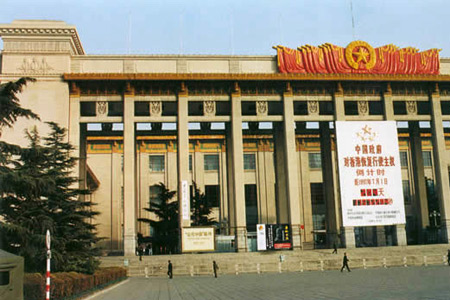Commencing at the beginning of this month, all national museums and provincial comprehensive museums in China have ceased to charge admission.

The China National Museum.Commencing at the beginning of this month, all national museums and provincial comprehensive museums in China have ceased to charge admission. (File Photo)
This is just the beginning of a program to open Chinese art to a wider audience. Central and local governments continue to invest more money into public cultural services and even more open policies are anticipated.
Duan is a regular museum-goer in Beijing. She came to the Military Museum for a regular Sunday morning visit.
Visitor, said, "I went up to buy a ticket. To my surprise, they told me the museum is free now. It's great! "
More than 300 museums, libraries and galleries across China have opened their doors to the public at no charge. In northeastern Heilongjiang Province, four local museums have adopted the new policy. After just a week the museums had drawn about 33 thousand visitors.
Free entry is attracting a lot of visitors. But the larger crowds have also caused air quality to diminish. Some museums lack climate control facilities. The only way to deal with the problem, for the time being, is to open the windows. That however can change the relative humidity and create a negative impact on some cultural relics.
Wang Zhenzhen, vice director, Cultural Dept., Heilongjiang provincial govt., said, "Free entry is not temporary - for just a few days. It's a permanent policy. So visitors do not need to come rushing to see the exhibits right away."
Close scrutiny by some visitors can also affect the exhibits. There are concerns that visitors who insist on touching could damage artifacts which are not protected in display cases. Many visitors simply do not understand the basics of preserving cultural relics. So, creating greater protection for the exhibits has become a matter of some urgency.
The early experiences of the free admission policy have led some museums in Hunan, Chongqing, Liaoning and Zhejiang to limit the number of visitors. The museums have also added new equipment to safeguard the displays.
In the past five years, nearly 50 billion yuan has been put into the Culture industry. Half of the money is invested in the countryside and western China. The fundamental infrastructure cost about 13 billion yuan. Beijing admires its new National Grand Theatre and soon there will be a new face on the National Museum of China. Artists and spectators already feel the impact of the changes.
Nie Jianhua, singer, said, "Before the high-qualified theatres and concert halls were almost all in Beijing, Shanghai, Guangzhou and some other major cities. But now I find good ones in northwest Wuwei, in Gansu Province."
Now more 80% of China's counties have public libraries. There are nearly 7,000 service networks offering radio, TV, films and Internet services, to over 100 million villagers. Another 300 million yuan will be spent to buy a thousand large vans, for recording or broadcasting performances between 2007 and 2010.
(CCTV March 4, 2008)